The Apple Thunderbolt Display Review
by Anand Lal Shimpi on September 23, 2011 2:56 AM EST- Posted in
- Displays
- Mac
- Apple
- Thunderbolt
- Thunderbolt Display
Brightness and Contrast
For brightness, black level, and contrast points, we use the same colorimeter setup described earlier. Specifically, we use an Xrite i1D2 with ColorEyes Display Pro, and take measurements at maximum and minimum brightness of white and black targets. Dynamic contrast is turned off. We also let the panels settle in for a half hour at the respective settings before taking any measurements.
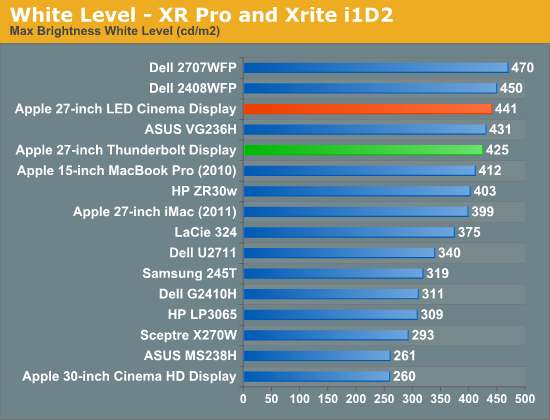
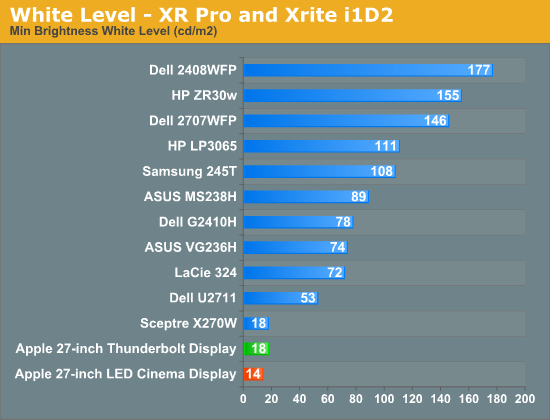
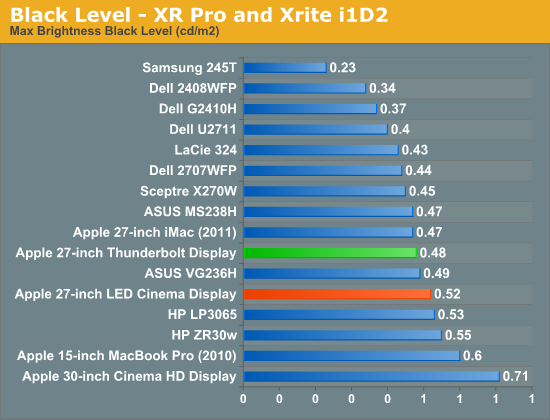
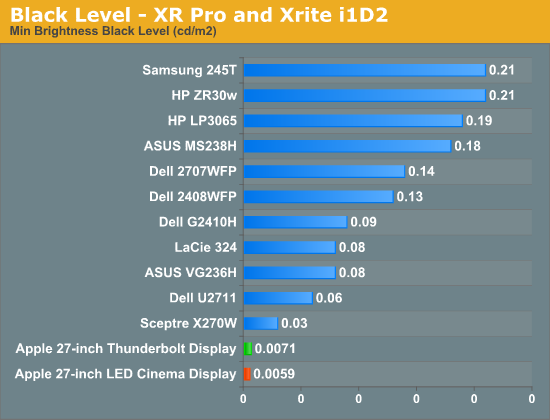
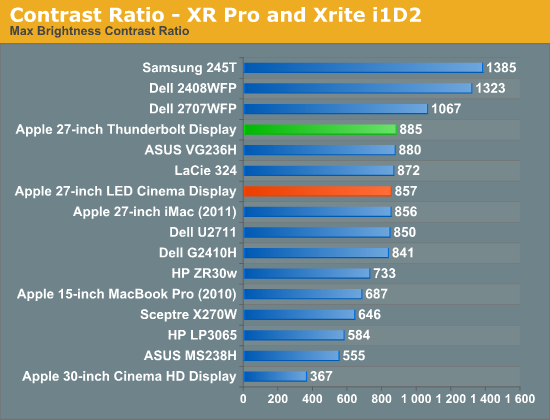
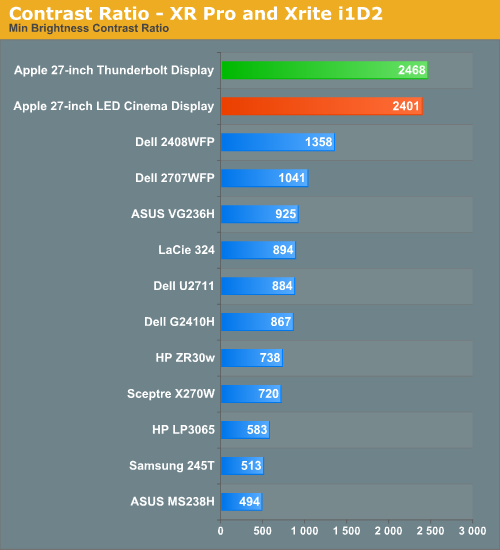
If you were expecting an change in panel quality you won't find it here. The Thunderbolt Display is almost exactly the same as last year's panel but with a bunch of new features.
Brightness Uniformity
In addition to the performance at center, we’ve also added 9-point testing for brightness, both white and black. This is done the same way we measure color uniformity, except we only care about measured intensity. We set the monitor to near 200 nits, and then measure those 9 points.
The Thunderbolt Display performed very well in these tests. The display was very consistent everywhere. Although the center of the panel measured about 8% brighter than the surroundings, it wasn't noticeable in actual use. Brightness uniformity was remarkably consistent through the majority of our measurements, even better than the original 27 we reviewed last year.
White Level Uniformity


Black Level Uniformity

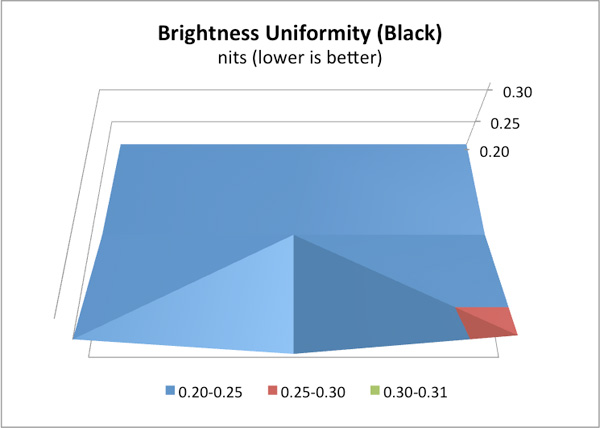
Viewing Angles
The Thunderbolt Display uses an IPS panel which guarantees good horizontal and vertical viewing angles. It doesn't matter how you tilt the display or from what angle you're looking at it (within reason), you'll get a fairly consistent image.















275 Comments
View All Comments
decryption - Friday, September 23, 2011 - link
No mention of how the built in Intel graphics perform on the high res screen? It was an initial concern of mine when the new MBA was released - how it would perform at that high resolution when paired up to a Mac running the 3000 HD graphics?Any UI lag? (e.g: mission control, swiping full screen apps, etc.)
boblozano - Friday, September 23, 2011 - link
Been using this combo for a couple of days and it's just about perfect. No lag, no complaints.I'd probably like usb3 and an sd reader as well, but those are nits.
MonkeyPaw - Friday, September 23, 2011 - link
I am surprised there's no card reader, but that's amendable by the USB. I don't understand the lack of audio ports. Macs are primarily media machines--how could they forget audio ports?!I guess you could use a USB sound card?
JasperJanssen - Saturday, September 24, 2011 - link
My guess is, Apple considers the humble analog audio port to be a dodo, except for use while actually on the move. But that's just speculation.All of the recent Intel-based macs that have been released, except the MacBook Air (and the Pro, which separates them), have an analog port that doubles as an optical output by plugging in the right (mini-TOSlink) optical cable -- maybe they would only want to include an audio port if it also included that optical part, which may well either make the port too deep for the regular port-location, and/or simply be too expensive. You could put a deeper port on the side of the monitor instead of the rear, but that would be both ugly and pretty expensive, as you'd have to add a whole extra PCB including a cable that goes to it.
Come to think of it, I'm not sure that at the location of the other port there is enough depth even for a regular 3.5mm jack, let alone a miniTOSlink variant. A 3.5mm jack is about 15-20 mm long and might well simply not fit between the aluminium back and the display backlight.
TypeS - Friday, September 23, 2011 - link
I really don't understand why people ponder this. Intel's integrated graphics don't do much for gaming at high resolutions (do AMD and NVIDIA's IGPS either?), but they've been fine for years now for high resolution monitors.Ryan Smith - Friday, September 23, 2011 - link
If you check the video Anand made for this article, he goes into more detail about MBA performance hooked up to such a large monitor. Overall the performance is respectable, but there are points where the GPU can't keep all of the GUI animations at 30fps.cactusdog - Friday, September 23, 2011 - link
Its nice to have less cables but this kit would cost around $2500? You can buy a similar res screen+notebook for around half that and take a few extra seconds to plug in a second or third cable.For work purposes most people would only really need to plug in the display cable (hdmi/displayport) anyway, and maybe ethernet if theres no wireless...
I dont think its worth the price premium unless you're getting it for free.....
TypeS - Friday, September 23, 2011 - link
Really... half? Dell wants $100 more for their 27" IPS 2560 x 1440 (16:9) display. And doesn;t come close to matching the capabilities of the Thunderbolt display. And a comparable notebook from Acer or Sony aren't much cheaper than the Macbook Air. So.. where are you getting this ultra portable notebook + 27" IPS display all together for only $1250?I don't like Apple much taking "facts" out of your arse is just as dumb as Steve Jobs' "magic".
cactusdog - Friday, September 23, 2011 - link
What are you talking about? The thunderbolt display is $1200 and the Dell is $899 but with discount you can get it for $750.The macbook starts around $1,300 with 13" screen and integrated graphics, then 15' + graphics is $1,699-$2000.
You can get a similar size/spec Asus or Samsung with discrete for around $900
cactusdog - Friday, September 23, 2011 - link
BTW, this is an apple advertisement. People should understand how things work by now and understand how Apple target their marketing.